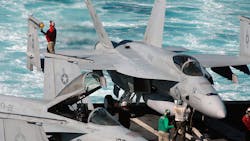Navy asks industry for information technologies for defending aerial weapons against enemy cyberattacks
LAKEHURST, N.J. – U.S. Navy aerial warfare experts are reaching out to industry for new ways of defending weapons from enemy cyberattacks, and to enable Navy weapons to survive and exploit cyber warfare capabilities.
Officials of the Cyber Warfare Detachment of the Naval Air Systems Command in Lakehurst, N.J., issued a broad agency announcement on Monday (N68335-19-R-0370) for resilient cyber warfare technologies for naval aerial weapons.
Navy officials want to orchestrate research to fill perceived gaps in cyber warfare capabilities; there is insufficient cyber research and threat information for weapons that connect digitally to one another. Commercially available information cybersecurity tools are ill-designed for weapons, especially considering size, weight and power (SWaP) restrictions, Navy officials explain.
Instead, Navy experts want to address cyberattacks on weapons in system-of-systems warfare, which involves often-intermittent or indirect connectivity to other systems. There has been little attention to these intermittent connections, such as maintenance laptop computers and mission loaders.
Related: The shadowy world of cyber warfare
Navy officials want to research physical and industrial control system interfaces with aircraft, such as aircraft launch and recovery equipment, power, and navigation umbilicals, reaching back to concept development, supply chain management, software assurance, and configuration management and as far forward as anti-tamper measures for battle damage assessment, equipment sanitization, and disposal.
Navy experts seek to defend access points to weapons; survive and continue to operate during close-quarters battle; and conduct cyber-smart acquisition.
Navy officials are interested in:
-- detection, protection, response, recovery from malware and/or effects on real time operating systems;
-- software-defined radio protections and capabilities;
-- warning systems, situational awareness, cueing for weapon system operators of malware, cyber-attacks, or impending cyber attacks;
-- ad-hoc networking security;
-- dynamic reconfiguration, compilation, and re-hosting for real-time operating systems;
-- tool sets for weapon systems cyber protection teams;
-- weapon system cybersecurity and threat assessment models;
-- identification and protection of trusted relationships necessary to real-time operating systems;
-- system-of-systems cyber architectures for analysis and weapons;
-- SWaP-restricted cross domain solutions;
-- critical access point determination and protection, detection, response, and recovery based on multiple spectrum apertures;
-- cybersecurity for aviation-related maintenance, logistics, data loader, common munitions reprogramming equipment, removable media, and other temporal connections;
-- non-destructive cyber inspection;
-- suppression and discovery of malware command and control;
-- cyber test capabilities for weapons;
-- cyber sensor placement and instrumentation;
-- full spectrum cyber response and enablement for multiple weapon system kill chains;
-- techniques for cyber fault mode effects;
-- sacrificial infrastructure and reactive cyber armor;
-- multi-source sensor data fusion for cyber defense;
-- autonomic, semiautomatic, and manual response decision tool for cyber intrusion or fault detection;
-- proactive, preemptive, and preventative cyber security responses for airborne weapons;
-- deterrent cybersecurity to increase adversary level of effort and costs;
-- remote access of sensors;
-- logging, reporting, and patching for intermittently connected weapons;
-- threat attribution, identification, and geo-location;
-- integrated security management system;
-- redundant back-up, mechanical, and voting cyber system constructs for resiliency.;
-- artificial neural network concepts for detection, reporting, and response to cyberattacks;
-- authentication constructs for weapon systems;
-- redundant and diverse mission critical logic to abandon compromised logic paths;
-- encryption, secure coding and configuration management during weapon system development;
-- secure chipsets and hardware architectures to establish a root of trust;
-- coordinated cyber and electronic warfare capabilities; and
-- airborne and maritime prototypes to develop and demonstrate cyber technologies.
Related: Cyber warfare takes a front seat in U.S. military operations
Companies interested should email proposals no later than 7 July 2020 to the Navy's Meryl Czaplinski at [email protected].
For questions or concerns contact Meryl Czaplinski by email at [email protected], or by phone at 732-323-7263. More information is online at https://www.fbo.gov/spg/DON/NAVAIR/N68335/N68335-19-R-0370/listing.html.

John Keller | Editor-in-Chief
John Keller is the Editor-in-Chief, Military & Aerospace Electronics Magazine--provides extensive coverage and analysis of enabling electronics and optoelectronic technologies in military, space and commercial aviation applications. John has been a member of the Military & Aerospace Electronics staff since 1989 and chief editor since 1995.

